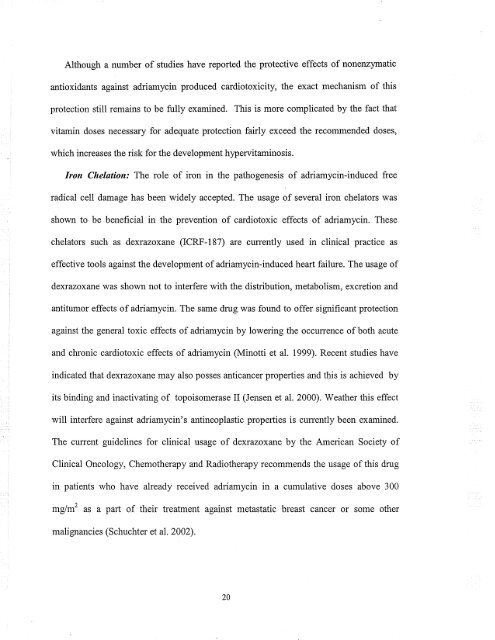il\VOLVEMENT OF RETII\OIC ACID II{ - MSpace at the University of ...
il\VOLVEMENT OF RETII\OIC ACID II{ - MSpace at the University of ...
il\VOLVEMENT OF RETII\OIC ACID II{ - MSpace at the University of ...
Create successful ePaper yourself
Turn your PDF publications into a flip-book with our unique Google optimized e-Paper software.
Although a number <strong>of</strong> studies have reported <strong>the</strong> protective effects <strong>of</strong> nonenzym<strong>at</strong>ic<br />
antioxidants against adriamycin produced cardiotoxicity, <strong>the</strong> exact mechanism <strong>of</strong> this<br />
protection still remains to be fully examined. This is more complic<strong>at</strong>ed by <strong>the</strong> fact th<strong>at</strong><br />
vitamin doses necessary for adequ<strong>at</strong>e protection fairly exceed <strong>the</strong> recommended doses,<br />
which increases <strong>the</strong> risk for <strong>the</strong> development hypervitaminosis.<br />
Iron Chel<strong>at</strong>ion: The role <strong>of</strong> iron in <strong>the</strong> p<strong>at</strong>hogenesis <strong>of</strong> adriamycin-induced free<br />
radical cell damage has been widely accepted. The usage <strong>of</strong> several iron chel<strong>at</strong>ors was<br />
shown to be beneficial in <strong>the</strong> prevention <strong>of</strong> cardiotoxic effects <strong>of</strong> adriamycin. These<br />
chel<strong>at</strong>ors such as dexrazoxane (ICRF-187) arc currently used in clinical practice as<br />
effective tools against <strong>the</strong> development <strong>of</strong> adriamycin-induced heart faiiure. The usage <strong>of</strong><br />
dexrazoxane was shown not to interfere with <strong>the</strong> distribution, metabolism, excretion and<br />
antitumor effects <strong>of</strong> adriamycin. The same drug was found to <strong>of</strong>fer significant protection<br />
against <strong>the</strong> general toxic effects <strong>of</strong> adriamycin by lowering <strong>the</strong> occurrence <strong>of</strong> both acute<br />
and chronic cardiotoxic effects <strong>of</strong> adriamycin (Minotti et al. 1999). Recent studies have<br />
indic<strong>at</strong>ed th<strong>at</strong> dexrazoxane may also posses anticancer properties and this is achieved by<br />
its binding and inactiv<strong>at</strong>ing <strong>of</strong> topoisomerase <strong>II</strong> (Jensen et al. 2000). We<strong>at</strong>her this effect<br />
will interfere against adriamycin's antineoplastic properties is currently been examined.<br />
The current guidelines for clinical usage <strong>of</strong> dexrazoxane by <strong>the</strong> American Society <strong>of</strong><br />
Clinical Oncology, Chemo<strong>the</strong>rapy and Radio<strong>the</strong>rapy recommends <strong>the</strong> usage <strong>of</strong> this drug<br />
in p<strong>at</strong>ients who have already received adriamycin in a cumul<strong>at</strong>ive doses above 300<br />
mglmz as a part <strong>of</strong> <strong>the</strong>ir tre<strong>at</strong>ment against metast<strong>at</strong>ic breast cancer or some o<strong>the</strong>r<br />
malignancies (Schuchter et al. 2002).<br />
20







![an unusual bacterial isolate from in partial fulf]lment for the ... - MSpace](https://img.yumpu.com/21942008/1/190x245/an-unusual-bacterial-isolate-from-in-partial-fulflment-for-the-mspace.jpg?quality=85)





![in partial fulfil]ment of the - MSpace - University of Manitoba](https://img.yumpu.com/21941988/1/190x245/in-partial-fulfilment-of-the-mspace-university-of-manitoba.jpg?quality=85)


